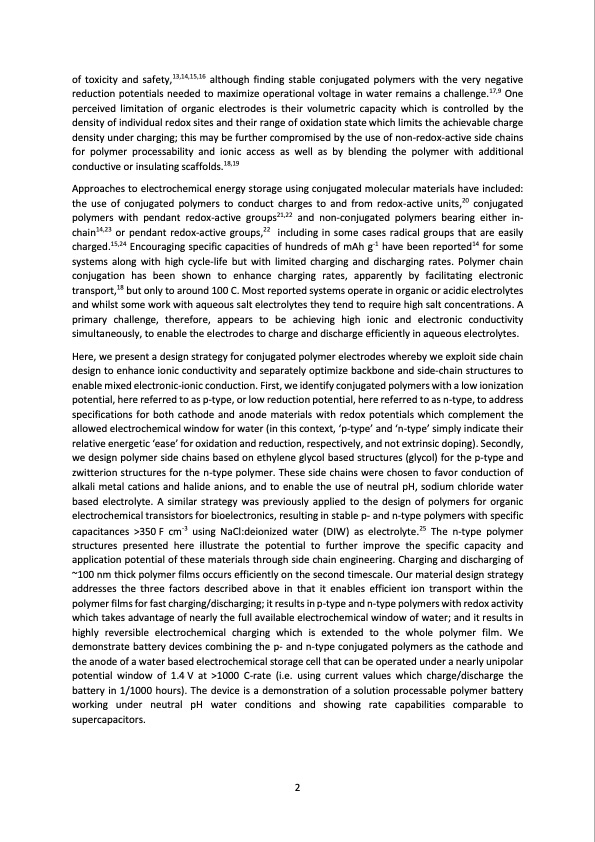
PDF Publication Title:
Text from PDF Page: 002
of toxicity and safety,13,14,15,16 although finding stable conjugated polymers with the very negative reduction potentials needed to maximize operational voltage in water remains a challenge.17,9 One perceived limitation of organic electrodes is their volumetric capacity which is controlled by the density of individual redox sites and their range of oxidation state which limits the achievable charge density under charging; this may be further compromised by the use of non-redox-active side chains for polymer processability and ionic access as well as by blending the polymer with additional conductive or insulating scaffolds.18,19 Approaches to electrochemical energy storage using conjugated molecular materials have included: the use of conjugated polymers to conduct charges to and from redox-active units,20 conjugated polymers with pendant redox-active groups21,22 and non-conjugated polymers bearing either in- chain14,23 or pendant redox-active groups,22 including in some cases radical groups that are easily charged.15,24 Encouraging specific capacities of hundreds of mAh g-1 have been reported14 for some systems along with high cycle-life but with limited charging and discharging rates. Polymer chain conjugation has been shown to enhance charging rates, apparently by facilitating electronic transport,18 but only to around 100 C. Most reported systems operate in organic or acidic electrolytes and whilst some work with aqueous salt electrolytes they tend to require high salt concentrations. A primary challenge, therefore, appears to be achieving high ionic and electronic conductivity simultaneously, to enable the electrodes to charge and discharge efficiently in aqueous electrolytes. Here, we present a design strategy for conjugated polymer electrodes whereby we exploit side chain design to enhance ionic conductivity and separately optimize backbone and side-chain structures to enable mixed electronic-ionic conduction. First, we identify conjugated polymers with a low ionization potential, here referred to as p-type, or low reduction potential, here referred to as n-type, to address specifications for both cathode and anode materials with redox potentials which complement the allowed electrochemical window for water (in this context, ‘p-type’ and ‘n-type’ simply indicate their relative energetic ‘ease’ for oxidation and reduction, respectively, and not extrinsic doping). Secondly, we design polymer side chains based on ethylene glycol based structures (glycol) for the p-type and zwitterion structures for the n-type polymer. These side chains were chosen to favor conduction of alkali metal cations and halide anions, and to enable the use of neutral pH, sodium chloride water based electrolyte. A similar strategy was previously applied to the design of polymers for organic electrochemical transistors for bioelectronics, resulting in stable p- and n-type polymers with specific capacitances >350 F cm-3 using NaCl:deionized water (DIW) as electrolyte.25 The n-type polymer structures presented here illustrate the potential to further improve the specific capacity and application potential of these materials through side chain engineering. Charging and discharging of ~100 nm thick polymer films occurs efficiently on the second timescale. Our material design strategy addresses the three factors described above in that it enables efficient ion transport within the polymer films for fast charging/discharging; it results in p-type and n-type polymers with redox activity which takes advantage of nearly the full available electrochemical window of water; and it results in highly reversible electrochemical charging which is extended to the whole polymer film. We demonstrate battery devices combining the p- and n-type conjugated polymers as the cathode and the anode of a water based electrochemical storage cell that can be operated under a nearly unipolar potential window of 1.4 V at >1000 C-rate (i.e. using current values which charge/discharge the battery in 1/1000 hours). The device is a demonstration of a solution processable polymer battery working under neutral pH water conditions and showing rate capabilities comparable to supercapacitors. 2PDF Image | salt water battery with high stability

PDF Search Title:
salt water battery with high stabilityOriginal File Name Searched:
salt-water-battery.pdfDIY PDF Search: Google It | Yahoo | Bing
Product and Development Focus for Salgenx
Redox Flow Battery Technology: With the advent of the new USA tax credits for producing and selling batteries ($35/kW) we are focussing on a simple flow battery using shipping containers as the modular electrolyte storage units with tax credits up to $140,000 per system. Our main focus is on the salt battery. This battery can be used for both thermal and electrical storage applications. We call it the Cogeneration Battery or Cogen Battery. One project is converting salt (brine) based water conditioners to simultaneously produce power. In addition, there are many opportunities to extract Lithium from brine (salt lakes, groundwater, and producer water).Salt water or brine are huge sources for lithium. Most of the worlds lithium is acquired from a brine source. It's even in seawater in a low concentration. Brine is also a byproduct of huge powerplants, which can now use that as an electrolyte and a huge flow battery (which allows storage at the source).We welcome any business and equipment inquiries, as well as licensing our flow battery manufacturing.| CONTACT TEL: 608-238-6001 Email: greg@salgenx.com | RSS | AMP |